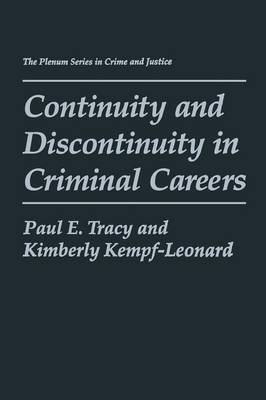The Plenum Series in Crime and Justice
2 total works
Delinquency Careers in Two Birth Cohorts
by Paul E. Tracy, Marvin E. Wolfgang, and Robert M. Figlio
Published October 1990
Delinquency in a Birth Cohort, published in 1972, was the first criminologi- cal birth cohort study in the United States. Nils Christie, in Unge norske lovorertredere, had done the first such study as his dissertation at the University of Oslo in 1960. Professor Thorsten Sellin was the inspiration for the U.S. study. He could read Norwegian, and I could a little because I studied at the University of Oslo in my graduate years. Our interest in pursuing a birth cohort study in the United States was fostered by the encouragement of Saleem Shah who awarded us a grant from the National Institute of Mental Health to begin our birth cohort studies at the University of Pennsylvania by investigating the delinquency of the 1945 cohort. We studied this group of 9,945 boys extensively through official criminal history and school records of their juvenile years. Subsequently, we followed up the cohort as adults using both adult arrest histories and an interview of a sample of the cohort. Our follow-up study was published as From Boy to Man, From Delinquen- cy to Crime in 1987.
Continuity and Discontinuity in Criminal Careers
by Paul E. Tracy and Kimberly Kempf-Leonard
Published 31 October 1996
It takes courage to do research on crime and delinquency. Such research is typically conducted in an atmosphere of concern about the problem it addresses and is typically justified as an attempt to discover new facts or to evaluate innovative programs or policies. When, as must often be the case, no new facts are forthcoming or innovative programs turn out not to work, hopes are dashed and time and money are felt to have been wasted. Because they take more time, longitudinal studies require even greater amounts of courage. If the potential for discovery is enhanced, so is the risk of wasted effort. Long-term longitudinal studies are thought to be especially risky for other reasons as well. Theories, issues, and sta tistical methods in vogue at the time they were planned may not be in vogue when they are finally executed. Perhaps worse, according to some perspectives, the structure of causal factors may shift during the execu tion of a longitudinal project such that in the end its findings apply to a reality that no longer exists. These fears and expectations assume an ever-changing world and a corresponding conception of research as a more or less disciplined search for news. Such ideas belittle the contributions of past research and leave us vulnerable to theories, programs, policies, and research agendas that may have only tenuous connections to research of any kind.

